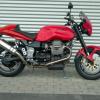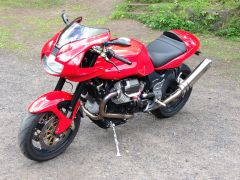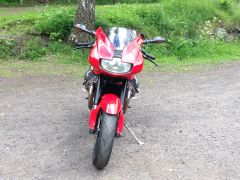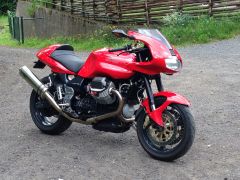-
Posts
34 -
Joined
-
Last visited
-
Days Won
2
Hansson last won the day on July 2 2015
Hansson had the most liked content!
Profile Information
-
My bike(s)
V11 Sport Ballabio '04
Recent Profile Visitors
1,296 profile views
Hansson's Achievements

Guzzisti (2/5)
16
Reputation
-
Hi Bob Maybe this thread can give you tips on possible cause of the noise (tapping) in your bike. I think your bike sounds the same as my did. The solution to my problem can be read on page three in the thread. Good luck! // Jörgen
-
I highly recommend the "stahlbus" bleeder valve. Works absolutely amazing! High quality. If you use these valves together with stahlbus "auxilary vacuum filling and bleeding device", bleeding will go very easily. Without spilling and messing up. On my bike: Front - M8x1,25x16mm Rear - M10x1,0x16mm https://drive.google.com/open?id=0B1cTu58Dx28vX1owTVNnMU1ucWs Take a look at their website! http://www.stahlbus.com/products/en/bleeding-system/index.php https://www.stahlbus.de/lng/en/bleeding-system/bleeder-valve/conical-sealing-standardtype/ http://www.stahlbus.com/info/en/products/product-overview Cheers
-
Thanks guys for a positive respons Here's a simple snapshot for you Scud, taken two days ago. Chuck, you have to wait until it gets warmer outside..
-
I've now managed to silence the clattering noise! The reason was as I suspected.. Too big backlash at the center of the (new!) friction plates. I decided to order new plates made by "Newfren", in the hope that they would be tight in the splines, but not even these were as tight as the old "AP". Now there are new clutch facing, taken from the new "Newfren" plates, mounted on the old AP clutch plates. The Newfren plates are 8,3 millimeters thick so I've let grind the plates to 8,0 millimeters. Yesterday I started the motorcycle for the first time after working on it, and found to my great delight the silence !! Today I did the first test trip and everything sounds and works perfect! Welcome, this year's season! It's time for many amazing miles on the road
-
I'm not so sure about this anymore.. I had a conversation with the gearbox guru Rolf Halvorsen, and he says that the movements and sounds of the gearbox is normal. In the search for the cause of the noise, I found another backlash. It's in the splines of the clutch friction plate. And there is more backlash in the newer replaced plates than in the old original plates, which have been running around 30,000 kilometers. It seems that the new plates are not as precisely produced, with accurate tolerance, as the original AP plates. Take a look at yet another video (Full Screen). Perhaps it's difficult to see how much difference the backlash between the plates is, but I see it as substantial. https://drive.google.com/open?id=0B1cTu58Dx28vbmlYN1QyVlJUSjA Thanks Lucky Phil, for your positive response. Just what I want to hear.. You confirm in a good way my own thoughts about aluminum flywheels for Guzzis (as thoughts of other manufacturers clutch baskets, and the toothed surface). Pete Roper has valuable references that should puncture discussions about the unsuitability of using aftermarket aluminum flywheels
-
If you are referring to this footgoose.. The TB balance, AFR balance, valve clearance and idle speed is super tuned. Recently run in bench. The compression is perfect and in balance. Can't you see Pete Ropers explanation "Any 'Knock' will most likely be the primaries in the gearbox flogging to and fro as the input shaft accelerates and decelerates with the crank." ?
-
Update. I think I've found the cause, from where the noise comes. There is backlash between the gears of first gear. There is also a small backlash between the gears of the second gear. https://drive.google.com/open?id=0B1cTu58Dx28vTmFlY2lkVEl0aFE This, I think, may be due to worn gear and/or worn needle bearings. There is no visible wear on the gears, but tolerance is perhaps small. I suppose it's difficult to measure the wear on the gears. I don't think the gears should be worn after just 34000 kilometers (21250 miles). The gearbox oil has been changed regularly every year. If I want to replace gears and needle bearings, it will be costly. Around 1200 euros. If I'm right, you can't buy gear for the first gear on the input shaft itself, so you have to buy a complete primary gear shaft assembly. This shaft will cost 680 euros. But I might take a chance on, only replace needle bearings. The flywheel, I will probably replace with a beautiful Ergal aluminum flywheel. Price about 500 euros. Of course I will also replace the clutch gear, although it is not particularly worn. I must admit that I'm little about to lose hope of this bike/make. Bad quality of parts and/or poor construction? Having to dismantle half the bike just to get access to the clutch or gear box is not fun... Don't try to come up with "there's no need to do that often." But yes, I also love the bike !! Ciao
-
I suppose it's the T-shaped part with Guzzi Code GU 02766300 you're talking about? You can buy it at Stein-Dinse for € 17.18. http://www.stein-dinse.biz/Complete-partlist/Unsorted/Indicator-light-box-Cal-EV::2463.html
-
I replaced the output shaft seal on my Ballabio -04 preventively when I did work on the gearbox. There was no leakage in the stock seal at 30000 kilometers. Make sure you get a seal with dust lip! HMB Germany, sell the right seal. It's not a directional seal. And I think it's a Viton seal. http://hmb-guzzi.de/Seal-Ring-gearbox-output-shaft-V11 Cheers
-
Yes, it is exactly as you say Scud. I also hate those situations!! I did the work to replace the clutch at the start of the season and made the decision to ride the bike. I actually rode to the end of the season. The knocking noise has not changed over time, and yes it started after the clutch job. I also replaced the springs with new ones at the clutch replacement. I'm pretty sure that the springs are correctly fitted and that everything is properly tightened. I have done the "put your ear to a dowel trick" without success to locate the noise. The noise goes through gear one to six, and in neutral. There is one point (in addition to the clutch is pulled in) when the noise is silenced, and that's when the bike is driving. Or when the bike is lifted on the paddock stand, engine run in gear and I brakes lightly. I think that exclude faulty throwout bearing. I told about the worn flywheel, and here is a pic of it. There was no noise before I replaced the clutch even though the flywheel was worn, but maybe the changed position of the intermediate plate and the clutch pressure plate due to new thicker friction plates has something to do with the noise problem? .
-
After I changed the friction plates and the steel intermediate plate and sealed the leaking gearbox, there are a tapping sound somewhere around the gearbox and clutch. I can't locate the noise. It's possible to silence the noise, if you quickly engage the clutch. But after a while occur the tapping sound again. The splines on flywheel is a bit worn. Could that be the reason? Maybe the intermediate plate and the clutch pressure plate strikes the flywheel in it's worn splines and make the noise? The clutch gear is in good condition. Or is the sound coming from the gearbox? Please tell me if you have experience of that sound, or an idea to the cause. Open the link and listen! (You hear when I engage the clutch) https://drive.google.com/open?id=0B1cTu58Dx28vVFIyS0hkejdqYlU Ciao Jörgen
-
Some tips.. 1: Don't lose the small washer that will sit at the end of the odometer transmission shaft. The arrow indicates where it should be, but you can't see it because it will probably remain in the gearbox housing. And don't forget to reassemble it! 2: Try to get the same (or similar) rotary shaft seals that sits originally fitted to the main shaft and the transmission shaft. I recommend (Corteco) Viton rotary shaft seals with a dust lip. Viton seals withstands high temperatures and will hopefully last longer. 3: When mounting the rotary shaft seal for the main shaft, be careful not to press it too deep, because then maybe it doesn't seal against the shaft. Note how the old it sits before you remove it! In my opinion, ThreeBond 1215 is the best sealant for works like this.
-

Tuning options for modified V11 -05 with Lambda
Hansson replied to Anders's topic in Technical Topics
Hi Anders I suggest you contact Tom Stålebrant at Italia Bike Center, in Arboga. He is capable of doing miracles with the power curve on a Guzzi, by remapping the ECU and correct the AFR. So you don't have to use an Power Commander. Thus, less equipment that may @#!#$# up . Of course, you need to run the bike on their Dyno during remap.







